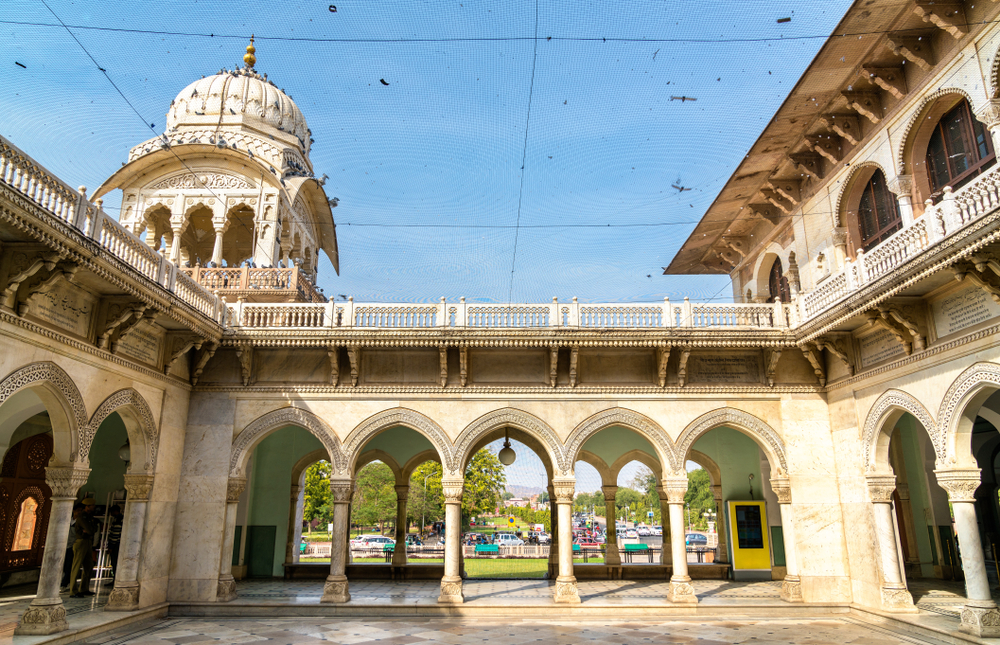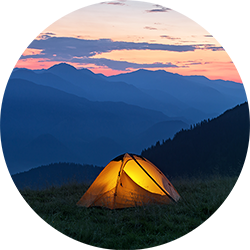The museum built in the year 1876, lies within the Ram Niwas Garden, Jaipur, and the oldest one in the state of Rajasthan.
It was first envisaged as a concert hall, bearing a resemblance to Victorian architecture and Albert Hall Museum, London.
The museum boasts of a wide range of objet d'art collected from various parts of the world and displayed over 16 galleries. With sundown, Albert Hall Museum assumes a completely new look because the whole building glimmers with brilliant yellow lights, looking stunning and spectacular.
The museum is the epitome of the rich history and culture of India.
Bordered by verdant gardens, the museum is a sight to behold for travelers flocking to Jaipur from all over the world.
The museum galleries feature numerous works of art and antique items including marble art, antique coins, Egyptian mummy, carpets, and pottery.
Besides, you can also see varied paintings, portraits, woodwork, brassware, and sculptures on display.
The museum also houses some of the best fineries, especially ceremonial dresses, worn by the royal family members. The museum is a must-visit for history buffs. The Indo-Saracenic style domes and elaborately engraved arches built of sandstone are sure to leave you awestruck.
Albert Hall also features an aviary, a greenhouse, as well as a zoo to delight tourists.
History of Albert Hall Museum -

The foundation of the museum was set when Albert Edward, the Prince of Wales visited Jaipur in the year 1876.
There was no certainty as to how the museum would be used, and therefore, on the recommendation of Maharaja Sawai Madho Singh II, a temporary museum was constructed in 1881.
It then exhibited the works of art created by the local artisans. Swinton Jacob, an eminent architect of that time, completed the construction of Albert Hall in 1887. It was then that the artifacts from the temporary museum were moved to the newly built Albert Hall.
By the year 1890, the museum stood complete with the Mayo Hospital within a public park, thus embodying the vision of the earlier Maharaja Sawai Ram Singh.
His descendant Sawai Madho Singh realized the Maharaja’s dream, thus depicting a new Jaipur city progressing into the contemporary age.
The Architecture of Albert Hall Museum -

Albert Hall Museum resembled the splendid Indo- Saracenic architecture, the hallways or corridors adorned with murals of diverse styles. It resembled the history and culture of the Egyptian, European, Greek, Babylonian, and Chinese civilizations.
Albert Hall soon became the centre stage for teaching the history of different civilizations. The museum-inspired artisans to hone their artistic skills as well as preserve traditional art, architecture, and craft forms of India.
When it comes to the architecture of the museum, the Egyptian mummy is a feast to travelers’ eyes as well as history aficionados.
The architecture of Albert Hall is the fusion of elaborate Islamic architecture and Neo-gothic style. The unique architecture of the museum used by the British in India and implemented in most public and government buildings.
The decorative and stylish components of this museum are one of the classic examples of architectural elegance and finesse of that period. If you have a penchant for design and architecture; you will love Albert Hall’s elaborate carvings as well as the distinctive ‘Chatri’ style towers that resemble impeccable artistry.

One of the striking features of Albert Hall Museum is its galleries displaying works of art, treasures, and antiques belonging to the nineteenth century. The popular galleries are:
1. Clay Art Gallery
It houses beautiful, delicate clay models of nineteenth-century displaying sociological themes, different yogic postures, and art of craft making.
You will find a clay model depicting judicial execution of that time, a plaster-cast clay model of a female leg painted with geometrical designs in red, a saint in a yogic posture, and many more.
2. Carpet Gallery
Visit this gallery to feast your eyes. The Persian Garden Carpet is the superlative example of stunning Persian carpets around the world.
Bought during the times of Mirza Raja Jai Singh I, the rare carpet represents a scene from a Persian garden. The work of art has four parts and numerous sub-sections.
Each part has varied colors that make the carpet look stunning. Birds, fish, turtles, and other Chinese animals are depicted on this carpet.
The gallery also houses circular carpets as well as doormats representing flowery and Mughal patterns.
3. Jewelry Gallery
You can see most of the low-cost jewelry worn by the peasants of that time. Most of the ornaments were made of brass and silver.
The popular items of jewelry include rings, anklets, bracelets, necklaces, and hairpins.
4. Coin Gallery
If you have a passion for coins, you must visit this gallery. Take a tour of this place to see a huge variety of coins of the British and Mughal age. You will love the punch-marked coins, which are ancient in history.
You can see numerous coins of the times of Jahangir, Akbar, Aurangzeb, and Shah Jahan. These coins were discovered from different parts of Rajasthan. They were collected and preserved in the museum gallery.
5. Musical Instruments Gallery
You will find ancient Indian musical instruments in this gallery of Albert Hall. The popular instruments include Dhap, Shehnai, Masak Baja, Karana, Rabab, and Pungi Ravan Hatha to name a few.
6. Marble Art Gallery
You can see some of the best exhibits of the nineteenth-century sculptures designed by the artisans of Jaipur in the Marble Art Gallery of Albert Hall.
The popular works of art include Dasa Avatar and Mahisasur Mardini, Nav Grahas and Ganesh, Shiv Pariwar, Jain Tirthankars, Vaishnav and Brahma Parivar.
7. Pottery Gallery
Albert Hall houses some of the finest pottery collections of the nineteenth century, representing diverse range, intricacy, and vitality of the craft tradition of India.
The gallery houses a range of flower vases. The most prominent one is the white quartz clay vase showing the king and queen on either side with cobalt blue and copper designs. You will also love to see the Kagazi (water bottle) doubled-handled surahi featuring a triangular design on the rim.
8. Arms and Armour Gallery
The gallery houses Mughal, Rajput, Afghan, Arab, Turkish hilts, swords, helmets, tiger knives, spears, clubs, and shields, in silver and gold.
The popular collections include Arabian dagger, Qama or knife, Goad, gun powder horn, tiger claws, Gauntlet, and more.





